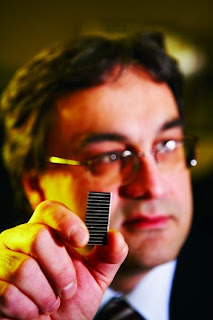A team of University of Minnesota-led researchers has cleared a major hurdle in the drive to build solar cells with potential efficiencies up to twice as high as current levels, which rarely exceed 30 percent.
By showing how energy that is now being lost from semiconductors in solar cells can be captured and transferred to electric circuits, the team has opened a new avenue for solar cell researchers seeking to build cheaper, more efficient solar energy devices. The work is published in this week's Science.
A system built on the research could also slash the cost of manufacturing solar cells by removing the need to process them at very high temperatures.
The achievement crowns six years of work begun at the university Institute of Technology (College of Science and Engineering) chemical engineering and materials science professors Eray Aydil and David Norris and chemistry professor Xiaoyang Zhu (now at the university of Texas-Austin) and spearheaded by U of M graduate student William Tisdale.
"This is a very promising result," said Tisdale. "We've shown that you can pull hot electrons out very quickly – before they lose their energy. This is exciting fundamental science."
The work shows that the potential for building solar cells with efficiencies approaching 66 percent exists, according to Aydil.
"This work is a necessary but not sufficient step for building very high-efficiency solar cells," he said. "It provides a motivation for researchers to work on quantum dots and solar cells based on quantum dots."
The next step is to construct solar cells with quantum dots and study them. But one big problem still remains: "Hot" electrons also lose their energy in titanium dioxide. New solar cell designs will be needed to eliminate this loss, the researchers said.
Still, "I'm comfortable saying that electricity from solar cells is going to be a large fraction of our energy supply in the future," Aydil noted. ###
The research was funded primarily by the U.S. Department of Energy and partially by the National Science Foundation. Other authors of the paper were Brooke Timp from the University of Minnesota and Kenrick Williams from UT-Austin.
Contact: Preston Smith smith@umn.edu 612-625-0552 University of Minnesota















No comments:
Post a Comment